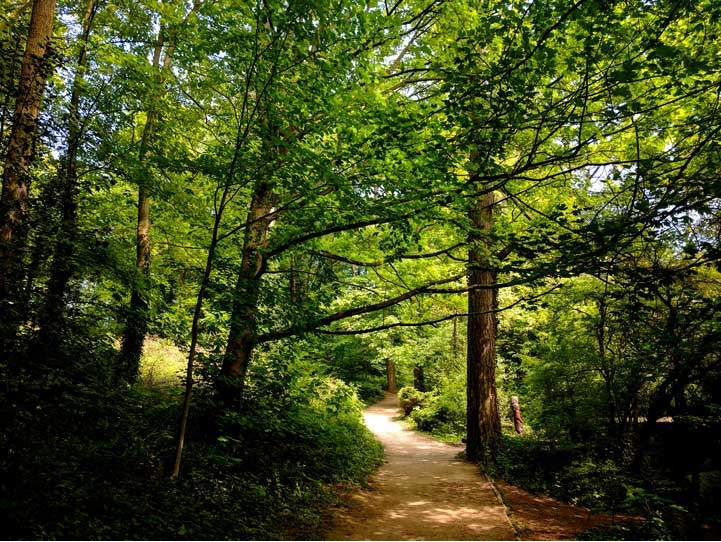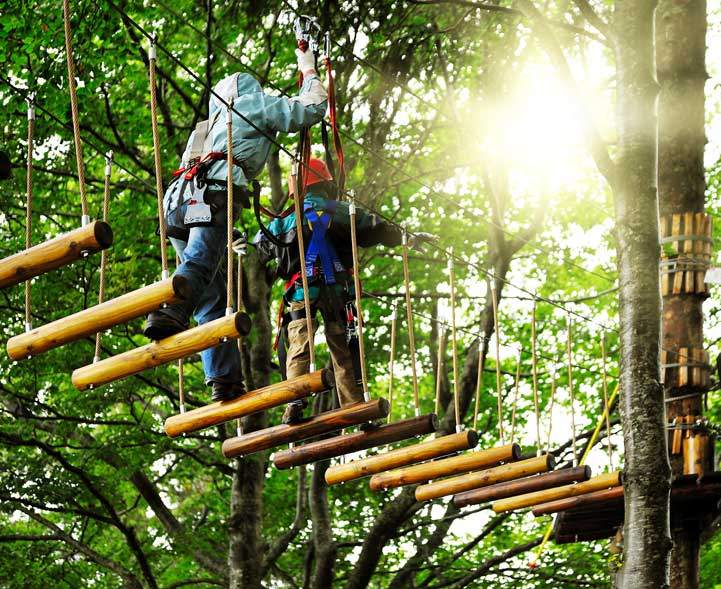In today’s socio-political climate, amenity woodlands, managed for people and for the environment are not only highly valued, but also have the potential for resilient, diversified income opportunities
A wood of one’s own?
The desire to get out and connect with nature has grown considerably since the pandemic, with many people dreaming of owning their own piece of wilderness
Woodland management is rising in importance, not just for returns from timber production but also for the environmental and social benefits well-managed woodlands can bring and for the diversification opportunities these enable. A renewed interest in woodlands is emerging as a result.
According to Forest Research, around 50% of people who have visited local woodlands as a result of Covid-19 restrictions reported an increase in their level of happiness when in the woods
Molly Biddell, Poilcy Analyst, Rural Research
There is no set definition for 'amenity woodlands', but traditionally they are smaller woodlands with a mix of tree species that are managed for a variety of recreational, cultural or environmental purposes. The one uniting definition of amenity woodland is that it is not managed purely for commercial timber production. The aesthetic, cultural and historical value of amenity woodlands is often important and therefore these woodlands require sensitive and holistic management. Amenity woodlands are best defined not by their size or price, but by their purpose.

At one with nature
Eighteen months of successive lockdowns has meant that the British public has had more time and inclination to explore the great outdoors, local woodlands included. According to Forest Research, around 50% of people who have visited local woodlands as a result of Covid-19 restrictions reported an increase in their level of happiness when in the woods. Over a third have increased their visits to woodland in the past year. This growing desire to get out and connect with nature has resulted in a surge in demand for parcels of amenity woodland. Covid-19 has reinforced many people’s dream of owning their own piece of wilderness.
How much do I want to spend?
Our research analyses Savills database of marketed amenity woodland properties with an area of less than 20 hectares and a price of less than £300,000. The analysis shows that between 2017 and 2021, the average asking price across the UK for a small block of amenity woodland (under five hectares) was just over £45,000. The average asking price for a larger wood (15 to under 20 hectares) across the UK was around £145,000. However, there is significant regional variability within these figures. The average asking price for a woodland of 15 to under 20 hectares in Scotland was just over £90,000, whereas in the east of England, the average asking price for the same size woodland was £200,000. Asking prices in the east and south east are the most expensive across the UK, where demand is greatest.
Since the lockdowns, we have seen an increase in demand for amenity woodland – clients are coming to us wanting to buy pockets of woodland as places to escape the city and reconnect with nature
Chris Spofforth, Savills Rural Agent, Sevenoaks
Local demand (driven by population density) and the frequency of buying opportunities are key metrics determining price, but affordability is, in reality, the primary concern of buyers, irrespective of the size or component parts. Additional factors that affect the price of amenity woodland include the level of privacy. Woods with significant public access are less attractive to private buyers. Road access and infrastructure such as hard standing, water points and possibly electricity provision may increase the value of a woodland, as options for personal utility and diversification are greater.
It is notoriously hard to place a value on an amenity woodland as woodland purchases are frequently made for specific and individual motivations. In amenity woodland sales, the final price is very often inflated by personal motivations – ultimately the value is in the eye of the beholder, and who wouldn’t value the chance to walk, manage and improve a piece of woodland you can call your own.
Size matters
Our research of marketed amenity woodland below 20 hectares from 2017–2021 also showed us that size matters. The average asking price across the UK for a small amenity woodland was in excess of £27,000 per hectare, however, the average asking price of larger amenity woodlands was below £9,000 per hectare. Our analysis also found that there are more smaller (up to five hectares) parcels of woodland for sale across the UK, because smaller woodlands are often seen as more manageable, as well as being more precious – a slice of wild nature to preserve. Many form small parts of larger woodlands, sold off in lots over time, and the wider management of the woodland may be a consideration, as different regimes may favour different objectives, so it is important to be clear what you want out of ownership.
More trees please
The government has set an ambitious tree-planting target to increase tree planting rates across the UK to 30,000 hectares per year by the end of this parliament – trebling current woodland creation rates. Increasing tree planting rates is seen as critical to tackling the climate and biodiversity crises, as well as fuelling a new green economy. The government is endorsing the principle of “right tree right place” and within that, there is a focus on planting or regenerating more native woodland. Across Scotland, England and Wales there is new and emerging funding for new woodland creation, as well as increased levels of funding for good woodland management. The incentives for investing in woodland creation or existing woodland management are at an all-time high.

Amenity woodland in the spotlight
Amenity woodland is often seen as the inferior, less productive cousin to fully-fledged commercial forestry assets. This Spotlight challenges that assumption and instead demonstrates that in today’s socio-political context, woodlands managed for people and the environment are not only highly valued, but also have the potential for resilient, diversified income opportunities. As with all land management, these opportunities don’t come ready served on a plate, they require careful planning, expertise and commitment but when these are managed correctly, the benefits of amenity woodlands are plentiful.
The environmental value of woodlands
Private markets and government funding are incentivising investment in the environmental benefits of woodland
Woodlands are habitats of enormous environmental value. A native woodland is the 'climax community' within natural ecological succession and, therefore, should have an incredibly high level of biodiversity, with complex multifunctional ecosystems. As society grows to value these ecosystems in new and innovative ways, funding from emerging private markets and government schemes is increasingly being channelled into developing the environmental resilience of existing woodlands and in creating new areas of woodland with a broad range of social and environmental benefits.
Woodland creation vs management
There is a significant difference between managing existing woodland and purchasing bare land to plant new woodland. The opportunities available through woodland creation differ to those from woodland management. Those wishing to invest in woodland need to be aware of the differences and think carefully about the intended purpose of their investment.
Charismatic carbon
As trees grow, they sequester carbon dioxide. Land managers who plant new trees on previously unwooded land can sell carbon credits to companies wanting to buy carbon offsets. Currently, it’s not possible to sell offsets from managing existing woods. However, in the future, schemes that enable managers to measure, accredit and commercialise the carbon sequestration from improved woodland management would create an incentive for better investment into existing woodlands.
Many land managers are planting new woodlands and banking the carbon credits to sell in the future as they anticipate the carbon price may rise as UK’s 2050 net zero target approaches
Molly Biddell, Poilcy Analyst, Rural Research
For woodland creation, the tree-planting must be verified and accredited by a standard such as the Woodland Carbon Code and this favours the creation of mixed species of native woodland over commercial timber plantations. In order to qualify as an offset, the project must prove additionality – in other words, it must prove that the tree planting is economically unviable if it weren’t for the carbon income that it will benefit from. Many land managers are planting new woodlands and banking the carbon credits to sell in the future as they anticipate the carbon price may rise as UK’s 2050 net zero target approaches.
'Charismatic carbon' describes carbon offset projects that have added value, for example, a tree-planting project that allows the investors to visit the trees, help with their management, enjoy the views, wildlife and enhanced biodiversity of the woodland. These projects have a story behind their creation, with multiple benefits, rather than being commodified, the carbon is 'charismatic' and so the price of the offset should be set higher. Existing and new amenity woodland is attracting strong interest from buyers who wish to manage woodland for its added value carbon opportunity.
Biodiversity
Amenity woodlands are valuable for their high levels of biodiversity. Within the context of mandatory biodiversity net gain, developers who require woodland-based biodiversity offsets will need to invest in either improving existing woodland management or creating new woodlands. This demand for offsets will theoretically generate a new source of funding for woodland owners. However, there are still many questions around how biodiversity net gain will be implemented at a local authority level. It is not yet clear whether land managers will be able to bundle ecosystem service provision from woodlands, which could enable biodiversity net gain investment to be compatible with carbon credit sales.
Riverwoods
There is a drive from government to incentivise planting woodlands for the benefit of watercourses. There are 242,262 km of watercourses in England alone – rivers and streams provide a natural corridor across the country. Establishing trees along these corridors creates new wet woodland habitats, improves water quality by reducing sediment and pollutant leaching, provides shade and reduces summer water temperatures, as well as slowing the flow of water and so preventing riverbank erosion. In England, the publicly funded initiative to plant along river courses is called 'woodlands for water', and in Scotland, it has been launched by the Scottish Wildlife Trust and is called 'Riverwoods'. As natural solutions to improve flood resilience and water quality become more cost-effective, it is likely that more private companies will want to invest in watercourse resilience. One solution could be to pay for land managers to plant more trees or manage woodlands around watercourses in a specific way.
.jpg)
A growing demand for woodland produce
Amenity woodland is traditionally seen as 'unproductive', however, there are established and emerging markets for products that derive from these woodlands. The timber from coppicing, regular thinning and general tree management can be cut into logs and sold as firewood. There is a growing market for well-seasoned logs for domestic use, particularly in light of the recent energy crisis and a consumer shift to renewable energy from biomass boilers. Tops from thinning and coppice timber can also be chipped into woodchip or wood pellets for use in biomass boilers. As well as creating fuel from woodlands, certain types of timber are often valuable for bespoke furniture creation (for example, oak, sycamore and beech).
There is a real increase in demand for firewood; the energy crisis and shift to domestic biomass boilers is meaning prices for good quality logs are at an all-time high
Mark Townsend, Forestry, Petworth
There are growing demands for 'foraging' for truffles, mushrooms and nuts and, in some cases, there are successful high-value markets behind these niche products. There is a plethora of alternative uses of trees, for example, medicinal purposes (eucalyptus and yew) and floristry (holly and ivy). Woodland owners may wish to enable others to create woodland product businesses through joint venture arrangements, or start small scale niche businesses themselves. Achieving profitability at scale may be a challenge.
Deer and squirrel management
Deer and squirrel control is one of the greatest challenges facing woodland managers. Grey squirrels, a non-native species, pose a threat to woodlands through bark stripping and they are also a threat to existing native red squirrel populations. Deer fray young trees and shrubs and can cause devastating damage to existing woodlands through browsing trees. The UK’s deer population is at an all-time high and is rapidly growing. This deer and squirrel damage leads to a loss of vulnerable tree species and may be accompanied by a decline in associated fungal and invertebrate fauna. The English government has a long-term strategy to help control grey squirrel populations. The most common deer management techniques are deer fencing, which is expensive, and regular culling, which requires expertise and skill.
.jpg)
The taxing question of woodlands
Understanding the tax treatment of amenity woodland is not simple. Income from timber sales is exempt from Income and Corporation Tax. In most cases, commercial woodland is eligible for relief from Inheritance Tax (IHT) when it is held as a trading asset. It’s possible to get relief from IHT through Woodland Relief, which defers any tax payable on the value of the timber until it is felled. To preserve national heritage, there is the Conditional Exemption Tax Incentive Scheme for woodland that is, or could be, on the inventory of Ancient Woodland kept by Natural England and Scottish Natural Heritage. This offers an exemption from IHT and CGT, providing certain criteria are met, which might be applicable to amenity woodland. In cases where income is derived from environmental management, taxation regimes may be different.
Managed for people
Amenity woodlands not only offer a valuable and enjoyable service to people, but woodland diversifications can also generate significant income streams
According to Forest Research, 88% of the UK agrees that forests and woodlands are important to them personally because they provide a space to relax and de-stress. Amenity woodlands offer a valuable service to people as somewhere to switch off, exercise and enjoy themselves. Woodland managers may wish to open up their woodlands to innovative business ideas that enable more people to experience nature, not only providing a positive social impact, but also generating a potentially significant income stream.
Health and well-being
The health and wellness benefits of exercise and switching off in nature are well known. Not only have scientists shown that nature benefits our mental health, but scientists have also found that accessing woodland can also reduce the risk of conditions such as diabetes, asthma, migraines and heart disease. Forest bathing, based upon a traditional Japanese concept of relaxation among trees, woodland yoga and forest-based retreats are trends where there is likely to be significant growth in the future. Green social prescribing, whereby spending time in nature is prescribed by GPs, is gaining more funding, particularly in Scotland. Using woodlands as a location for sporting events is also a growing trend – marathons, triathlons, mountain biking, zip-wiring, climbing and extreme events such as Tough Mudder are very popular. Woodland managers wishing to leverage the enduring health, wellness and exercise trend are well placed to do so.
Forest school, a type of schooling that takes place outdoors, encouraging children to learn immersed in nature, is a Scandinavian concept that is gaining interest across the UK
Molly Biddell, Poilcy Analyst, Rural Research

Learning from nature
Forest school, a type of schooling that takes place outdoors, encouraging children to learn immersed in nature, is a Scandinavian concept that is gaining interest across the UK. Enabling children to be closer to nature, especially by learning and exploring in wooded areas and forests, was recognised as a key action in the government’s 25-year Environment Plan. Woodland managers can create license agreements with forest schools to provide space for learning. Land managers may also want to engage with forest schools to help educate others on woodland management.
Woodland events
Woodland weddings, parties, festivals, conferences and even burial grounds are gaining in popularity. Woodlands are also often used as film or photoshoot locations. It is important to take a holistic approach to event management in woodlands. These diversifications can yield high returns, however, the benefits need to be assessed alongside any trade-offs. Planning restrictions, building regulations and environmental impact assessments are likely to be the biggest barriers to diversifying woodland use. However, if woodland managers focus on creating good quality, low impact, carefully thought through diversifications that fit the landscape, these risks are minimised.
Trees and woodland are top of the agenda for more reasons than just carbon at the moment. Be it glamping, treetop adventures, mountain biking, education, forest bathing, foraging or good old-fashioned walking; with people’s increased desire to escape cities, get back to nature and explore the UK, opportunities within our woodlands are on the increase
Hugh Vere Nicoll, Tourism, Leisure and Events Consultant, Savills
